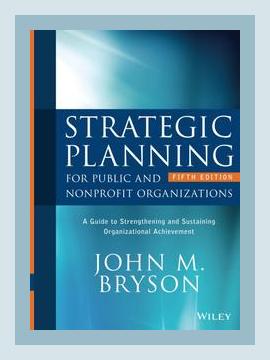Business StrategyStrategic Planning
Introduction to Strategic Planning
In “Strategic Planning for Public and Nonprofit Organizations,” John M. Bryson offers a comprehensive guide on how public and nonprofit organizations can develop effective strategies to meet their missions, improve performance, and create public value. The book covers every aspect of strategic planning, from initial preparation to implementation and evaluation. Drawing on numerous real-world examples, Bryson provides a robust framework for practitioners in these sectors.
Key Concepts and Framework
Strategic Planning Cycle:
Bryson introduces the Strategic Planning Cycle, which includes the following stages:
1. Initiate and Agree on a Strategic Planning Process
2. Identify Organizational Mandates
3. Clarify Organizational Mission and Values
4. Assess the External and Internal Environments
5. Identify the Strategic Issues Facing the Organization
6. Formulate Strategies to Manage the Issues
7. Review and Adopt the Strategies or Strategic Plan
8. Establish an Effective Organizational Vision
9. Develop an Effective Implementation Process
10. Reassess Strategies and the Strategic Planning Process
Initiate and Agree on a Strategic Planning Process
Major Point: To begin strategic planning, stakeholders must agree on the need for, and scope of, the process. It’s crucial to address the organization’s specific context, resources, and constraints.
Example and Actionable Advice: An example given is a small nonprofit health organization in Minnesota, which began by conducting initial meetings with board members, staff, and key stakeholders.
– Action: Convene a kickoff meeting with key stakeholders to discuss the goals and structure of the strategic planning process. Document agreements and outline responsibilities.
Identify Organizational Mandates
Major Point: Organizations must recognize and understand the regulatory and legislative mandates that govern their operation.
Example and Actionable Advice: A city council in California performed an extensive review of state laws and city charters to determine their mandates.
– Action: Assign a team to conduct a thorough review of all relevant mandates, regulations, and policies that affect your organization’s operations.
Clarify Organizational Mission and Values
Major Point: Defining a clear mission and set of core values is fundamental to guide strategic planning.
Example and Actionable Advice: Bryson cites a public library that articulated a mission to promote literacy and lifelong learning, aligning it with community values.
– Action: Organize a workshop with staff and stakeholders to draft or revise the mission statement and core values, ensuring alignment with community needs and organizational strengths.
Assess the External and Internal Environments
Major Point: A comprehensive analysis of external opportunities and threats along with internal strengths and weaknesses (SWOT Analysis) is essential.
Example and Actionable Advice: Bryson describes a regional transportation authority’s SWOT analysis, which highlighted external funding opportunities and internal procedural inefficiencies.
– Action: Conduct a SWOT analysis with key team members and stakeholders. Use surveys, focus groups, and market research tools to gather data.
Identify the Strategic Issues Facing the Organization
Major Point: Organizations must identify the strategic issues they face, which are fundamental policy questions or challenges that affect mission achievement.
Example and Actionable Advice: A nonprofit environmental organization identified climate change impact and limited funding as strategic issues.
– Action: Use the data from SWOT analysis to facilitate a strategic issues workshop. Encourage brainstorming and prioritize issues based on their potential impact on the mission.
Formulate Strategies to Manage the Issues
Major Point: Developing actionable strategies to address the identified strategic issues is crucial for effective planning.
Example and Actionable Advice: An example includes a state health department developing strategies for improved disease surveillance and health education programs.
– Action: Form cross-functional teams to elaborate on strategies to address the top strategic issues. Each team should draft a strategy document outlining objectives, timelines, resources, and performance indicators.
Review and Adopt the Strategies or Strategic Plan
Major Point: Once strategies are formulated, they need to be reviewed, refined, and officially adopted by the organization.
Example and Actionable Advice: Bryson shares the experience of a university that used a strategic planning committee to review the plan before presenting it to the board for final approval.
– Action: Establish a review committee comprising representatives from different organizational levels. Hold a review session and incorporate feedback before submitting the strategic plan for formal adoption.
Establish an Effective Organizational Vision
Major Point: Crafting a future-oriented vision helps unify stakeholders and guide strategic initiatives.
Example and Actionable Advice: A housing authority envisioned a community with affordable, quality housing and revitalized neighborhoods over the next decade.
– Action: Facilitate visioning workshops with stakeholders to co-create a shared vision statement. Ensure the vision is inspiring, realistic, and achievable.
Develop an Effective Implementation Process
Major Point: Transitioning from strategy formulation to implementation requires a well-structured process.
Example and Actionable Advice: Bryson details how a nonprofit used a project management approach to assign roles, set milestones, and allocate resources for implementing its strategic plan.
– Action: Create an implementation plan with detailed action items, responsible parties, timelines, and monitoring mechanisms. Establish a project management office (PMO) if necessary to oversee implementation efforts.
Reassess Strategies and the Strategic Planning Process
Major Point: Continual reassessment ensures that strategies remain relevant and effectively address emerging challenges and opportunities.
Example and Actionable Advice: Bryson highlights a public school district that conducted annual evaluations of its strategic plan, making adjustments based on performance data and changing conditions.
– Action: Schedule regular strategy review sessions. Use performance metrics and stakeholder feedback to assess progress and make necessary adjustments.
Conclusion
John M. Bryson’s “Strategic Planning for Public and Nonprofit Organizations” is an essential resource for anyone involved in the strategic planning processes within public or nonprofit sectors. By offering a structured approach with practical examples and actionable steps, Bryson equips organizations to craft strategies that foster mission accomplishment and public value creation. Future-proofing organizations through strategic planning is vital, and adhering to the structured framework as outlined by Bryson can significantly enhance the effectiveness and sustainability of public and nonprofit endeavors.
